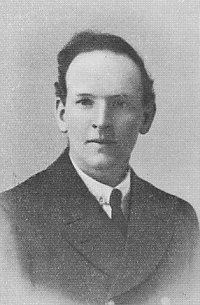
THOMAS LESLIE MAKEPEACE
It is difficult to understand how a person named on two WW1 memorials in Portsmouth is not listed by the Commonwealth War Graves Commission as having lost his life as a result of service during the war. As of 2014 Thomas Leslie Makepeace has not been so recognised which means that the principle source of information about his service career comes from a memorial booklet published by the Southern Grammar School.
The Makepeace family were one of the many who made their home in Portsmouth because of the Royal Navy. Thomas Leslie's father, Thomas Topping Makepeace, was born in Northumberland in 1856 and though he was probably serving in the navy from the 1870s did not move to Portsmouth until after his marriage to Agnes Mackay at Newcastle in 1884. The exact date of the move is not known but by the 1891 census they were living at 153 New Road with their first two children Daisy (b. 1886) and Thomas Leslie (b. 1889).

By 1901 the family had moved to 22 Hampshire Street and grown by the addition of two more children - Sydney (b. 1895) and Harold (b. 1899). In the same year Thomas Leslie began attendance at the Higher Grade School on Victoria Road North where he stayed until 1903. He worked hard and took a high place on the Dockyard list in 1903 and after serving his apprenticeship he entered the Navy as an Engine Room Artificer in 1909, serving on H.M.S. Roxburgh, Good Hope, and Diadem.
By 1911 Thomas's father had retired from the navy and moved the family to 3 Claydon Avenue, close to Fratton Park. His income as a naval pensioner was augmented by Agnes who worked as a 'Stationery Engine Driver' for the Corporation.
In 1913, prior to the outbreak of the Great War, Thomas Leslie entered the Submarine Service and was appointed to D4. He was later transferred to Submarine E2, serving in both the North Sea and the Sea of Marmora. In the latter place the work was especially trying and dangerous. The strain told on his health but he would not give in until compelled to do so, and was finally invalided for nerve collapse. He never became really better, and finally died in hospital, probably at Dartford in Kent, at the age of 30 years.
Further Information
The photograph above is taken from a memorial booklet published by Southern Grammar School from which extracts also appear above.
The Commonwealth War Graves Commission (CWGC) website does not list Thomas Leslie Makepeace.
Thomas Makepeace is remembered on the Southern Grammar School WW1 Memorial and on the Cenotaph. He is not listed in the 'National Roll of the Great War'.